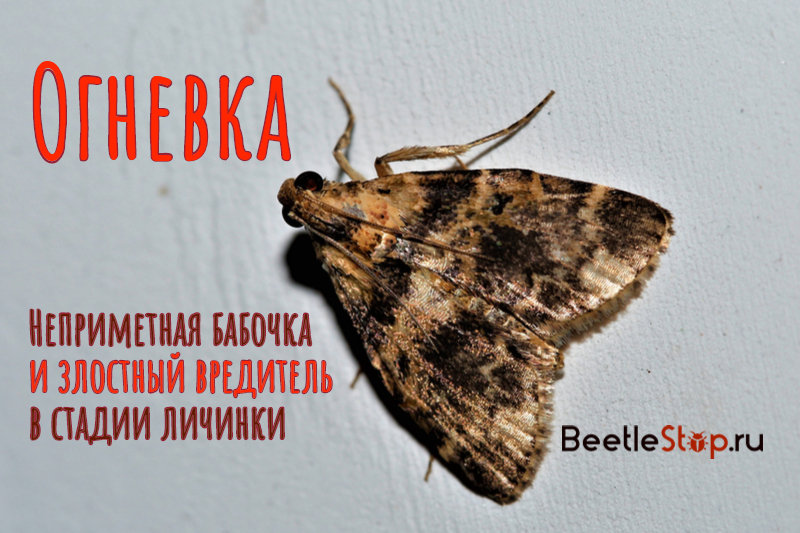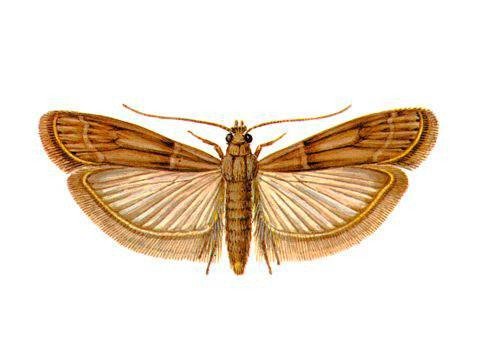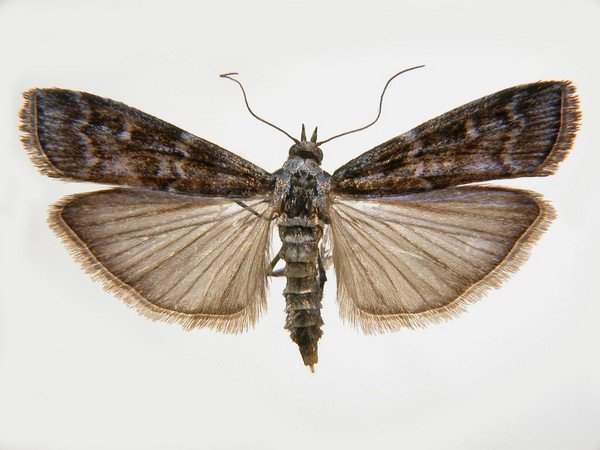Who is the fire: getting to know the most common types

Ognevka is a large family of more than 6 thousand species of insects. Among them, there are very small ones, but at the same time they turn out to be very serious pests of stocks, and real giants are butterflies with a wingspan of about 8.5 cm. Today we will meet representatives of the most common species. Some of them are quite curious, since, along with their harmfulness, they can bring significant benefits to a person.
Description
An adult moth is a small or medium sized butterfly with a wingspan of 1.1 to 8.5 cm, which will depend on the species of the insect. Sexually mature individuals have a thin body and relatively long legs.
On the head of the butterfly there is a pair of clearly distinguishable several convex eyes and antennae. In females, the latter are filiform, in males, they may carry cilia. The oral organ is represented by a sucking proboscis. At this stage of development, it is usually underdeveloped, in some species it may be very short or completely absent.
Wings: front — narrow and elongated, or triangular in shape; a median cell or several veins can be located on them; the posterior ones are wide, in most species of a rounded shape and with a short fringe along the edge. In females of some species, wings are rudimentary.
Most moth butterflies prefer twilight and nightlife. Representatives of these species are painted mainly in dark colors, and the main color is gray. But there are those who fly during the day - their color is colorful, bright. Insects at this stage of development, due to the fact that the oral organ and digestive system are underdeveloped, do not feed.
It is interesting! There are species whose range is alpine regions. Such butterflies fly out even at a time when the snow is in a rather dense layer!
Caterpillar
Fireworm larvae are small caterpillars with 8, less often with 7 pairs of legs. The head is small, small, naked, shiny. The body of the caterpillar is covered with dark warts, from which short bristles grow.
It is the larvae that are harmful. They can feed on leaves and buds of plants, berries, grains, dried fruits, etc. Caterpillars can live in the ground - in the root system of cereals, as well as in the legumes of the legumes, in the stems and young shoots of some plants and in places where food supplies are stored.
Life cycle
Years of butterflies are usually observed twice a year - in May and June. Representatives of species living in the southern regions of Russia can fly three times - the last time is around August. At this time, the females make masonry, leaving at a time a couple of eggs on the lower surfaces of the leaves of wild and cultivated plants. The fertility of one female is about 100 eggs.
Development in an egg takes about 7 days, after which caterpillars appear. The larval phase can last 2-4 weeks, then the generation descends into the soil, where it entraps itself in a cocoon and pupates.
On a note! The most active distribution of fire spills on the territory of our country was observed in rainy years, both in the middle and in the southern zone. The parasite significantly damaged beet plantations, chestnuts, garden and garden plantings. To a large extent, the moths influenced the quantitative and qualitative indicators of the yields of carrots, cabbage, currants, gooseberries, pears.
Wax moth
Our list of the most common types of fireworms of the representative of the family Galleria mellonella begins - a large wax moth and Achroia grisella - a small wax moth. These insects are conventionally united under the same name as a bee fire. It is one of the most dangerous pests of honey bees and is common everywhere where beekeeping flourishes.
Description
A sexually mature moth (wax moth) is a butterfly with a wingspan of about 3.4 cm and a body length of 1.8 to 3.8 cm. Like all representatives of this family, this insect has two pairs of wings: the front ones are gray-brown, covered dark spots and with a yellowish-brown fringing; the rear ones have a lighter shade. Females are larger than males.
Eggs are whitish in color and 0.5X0.35 mm in size. Embryonic development lasts from 5 to 8 days, after which larvae emerge from the eggs. They live in beehives and feed on wax. The larva of the first age has 4 pairs of legs. The size of her body is not more than 1 cm. Over time, the caterpillar increases in size, and the length of her body can reach 1.8 cm. The color of the head also changes: from light yellow to brown.
On a note! One bee larva larva over the entire period of its development can damage several hundred wax cells!
The larval phase lasts from 25 to 30 days, after which the caterpillars hide in secluded places, for example, in crevices, cracks or in independently gnawed holes where they pupate. In the process of its development, the pupa changes its initial yellow color to a darker brown. Subsequently, adult butterflies emerge from cocoons. Life expectancy of winged females is 8-12 days, males - 10-26 days.
Malware
The larvae of the bee moth feed on honey, bee bread, and when growing up, they change their diet and begin to absorb the wax honeycombs, along with parts of the cocoons left there. In addition, in the process of advancement, the caterpillars entangle the passages with their silk threads. During the life of the parasite, not only the cells are damaged, but also the framework, the material that served to warm the hives, and brood, and the volumes of honey and bee bread are rapidly decreasing.
During overpopulation of the caterpillar of the bee moth, they begin to lack food and eat each other or larvae from the previous litter. When this parasite appears, bee colonies noticeably weaken. Sometimes bees leave the hive, but most of them always die.
Benefit
In folk medicine, a tincture created on the basis of larvae of this type of fireplug is widely known and quite actively used. This tool has proven itself very well in the treatment of tuberculosis, diseases of the joint tissue, atherosclerosis, oncology and other pathologies.
In addition, during a unique experiment it was proved that wax moth caterpillars have a unique ability to decompose polyethylene: after 40 minutes, the larvae left several holes in a plastic bag, and in 12 hours 100 individuals were able to absorb 92 mg of this material. Moreover, the caterpillars of the bee moth are not only eating polyethylene, but also decompose it. This is facilitated by the hemogenate, which is located in the body of the larvae, and ethylene glycol is formed as a result of plastic processing.
Dried fruit
This type of fire is synanthropic, that is, their life is closely connected with a person and his dwelling. Dried fruit moth is widespread everywhere, only the Arctic is an exception, and it always settles exclusively in heated rooms where food supplies are stored.
Description
An adult is a butterfly whose wingspan can range from 1.5 to 2.2 cm. A pair of black eyes with a greasy shine and dark gray or yellowish-gray antennae, which may have a faint golden shine, is located on the head. Labial palms protruding forward, when viewed from above, they protrude in front of the forehead and form a cone. The head itself is painted in dark gray, light and brown blotches are visible on it. The front pair of wings is dark gray or ocher-gray, with grayish-white specks.

The larva of the dried fruit moth is a caterpillar with a cylindrical body, the length of which is 1.2-1.4 cm, the width is no more than 0.2 cm. In the northern regions this species of moths gives 1-2 generations per year, in the southern regions for one a year can develop up to three generations.
Malware
Inhabited in storage, dried fruit larvae can damage stocks:
- dried fruits;
- Confectionery
- nuts
- grains of some cereals;
- cotton seeds, etc.
On a note! In general, dried fruit moth is able to successfully live and develop in many food supplies, and even “fragrant” garlic is no exception!
Pine cone
A pine cone is a pest of coniferous trees that damages their cones. The species is widespread throughout the Palaearctic region. On the territory of the Russian Federation it is found everywhere.
Description
The wingspan of a pine cone butterfly is 2.5-3 cm. The front pair is decorated with light stripes in the form of zigzags located transversely, there is a dark border on the edge, there are dark and light spots. The main color of the rear pair of wings is light gray, they also show a dark border.

The larva of the pine cone is a caterpillar, the size of which can be from 2 to 2.7 cm. The integument is painted in brown-brown or yellowish-gray color, there is a fuzzy pattern composed of murky gray stripes arranged longitudinally. The head is red-brown.
For one vegetative period, the cone mumps gives one complete generation and the second optional.
Malware
The larvae of the pine cone damage the cones:
- ate:
- pine trees;
- Siberian cedar;
- Siberian fir;
- Caucasian fir, etc.
If the year turned out to be a lean one, then the caterpillars change their diet somewhat, including in it the buds and young shoots of spruce and pine. Eating cones, the pest leaves reddish-brown excrement on them. Such bumps become brown.
Acacia Fire
Acacia ’moth, or bean moth, is one of the most harmful insects for the legume crop. Infection occurs in the fields, from where the larvae get into the storage with the affected raw materials, where they complete their development.
Description
The wingspan of the acacia moth is 2.2-3 cm. The front pair of wings has a bluish-gray color, there is a pattern composed of a bone white stripe and an internal orange band. The main color of the rear translucent pair of wings is light gray, a dark strip is visible along the edge.
The larva of the acacia moth is a caterpillar about 1.5–2.2 cm in size. The color of the integument is variable: from pinkish to dirty green and brown. Head color is dark brown.
Malware
Acacia fire is capable of affecting:
- peas;
- soy;
- beans;
- astragalus;
- yellow acacia;
- white acacia;
- lentils;
- lupine;
- alfalfa;
- clover, etc.
In general, the diet of this parasite includes more than 80 species of wild and cultivated plants. Most preferred are large-fruited varieties.
On a note! With a large number of colonies, the pest can destroy up to half the volume of the entire crop!
As a result of parasitization of the acacia moth, both seed, which subsequently gives very poor germination, and products of the product line suffer.
Cabbage fire
Cabbage fire is familiar to many gardeners. The larvae of this insect species appear around the month of May and June and eat cabbage leaves.By the end of June, the development of this stage ends, the caterpillars go into the soil, where they pupate. Years of butterflies fall in August, they lay eggs on the lower surface of the leaves of the same cabbage and weed grass, and already in the fall the second generation emerges from them, which hibernates in the soil and pupates in the spring of next year. At the same time, the period of the ovipositor can stretch very much - up to a month, sometimes longer.
Description
The cabbage moth butterfly has a wingspan of about 2.5-2.6 cm. The front pair is painted dirty yellow, the pattern is composed of two brownish stripes, between which there is a spot. The rear pair of wings is light yellow.

The larva of the cabbage moth is a caterpillar, the color of which, as it develops, changes from light yellow to yellow-green. The body size of a young larva is approximately 2 cm, and that of an adult is 3 cm. On the back there are two light, well distinguishable stripes. The head is light brown.
Malware
The larvae that hatch from the eggs harm, begin to “scrape” the lower surface of the leaf plates, while no through holes are formed. As the caterpillars grow, they cause more and more noticeable damage, and mature individuals can already bite holes. In addition to cabbage, beetroot and horseradish are also included in the diet of cabbage moth larvae.


 (votes: 7, average rating: 4,57 out of 5)
(votes: 7, average rating: 4,57 out of 5)